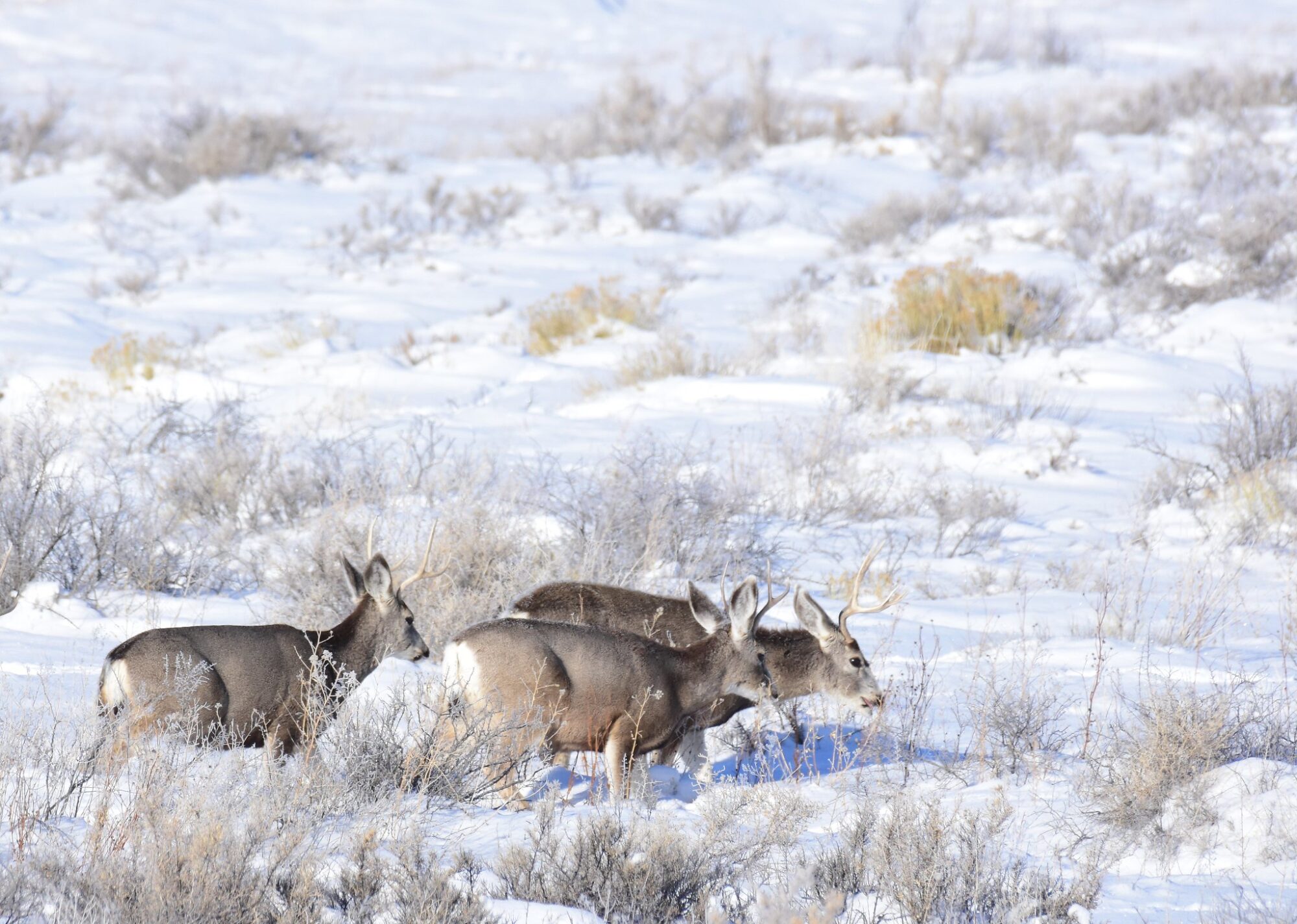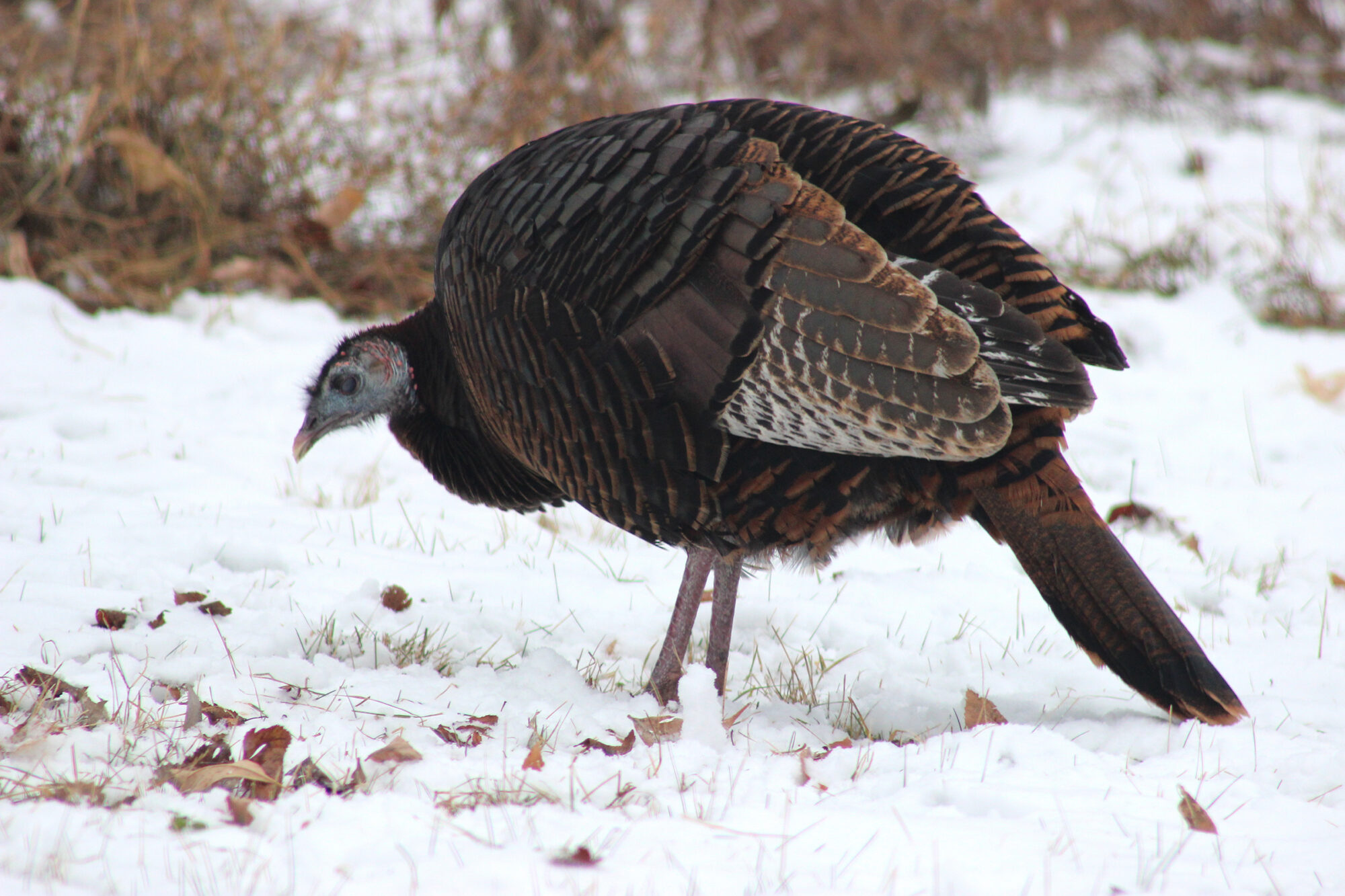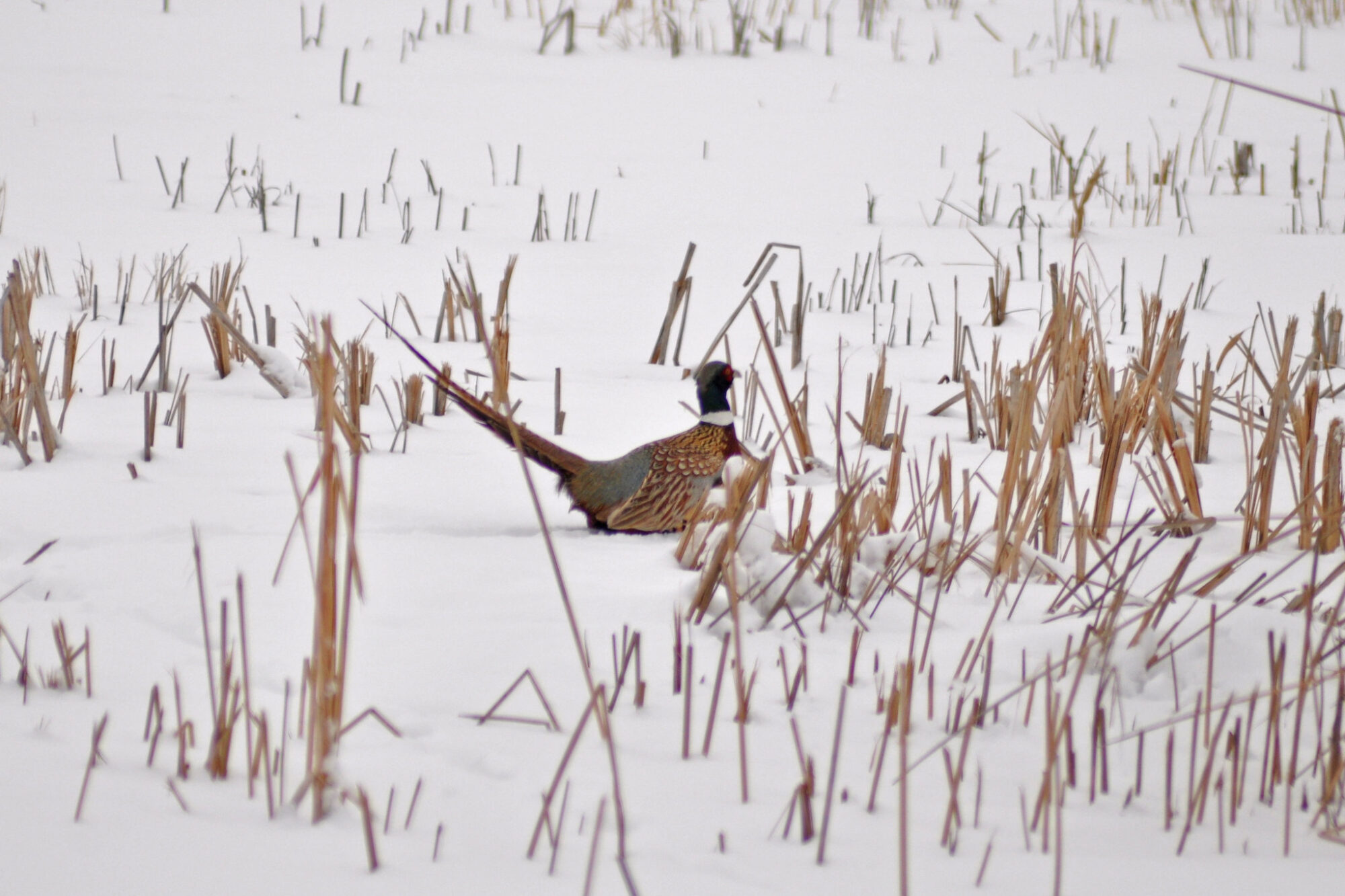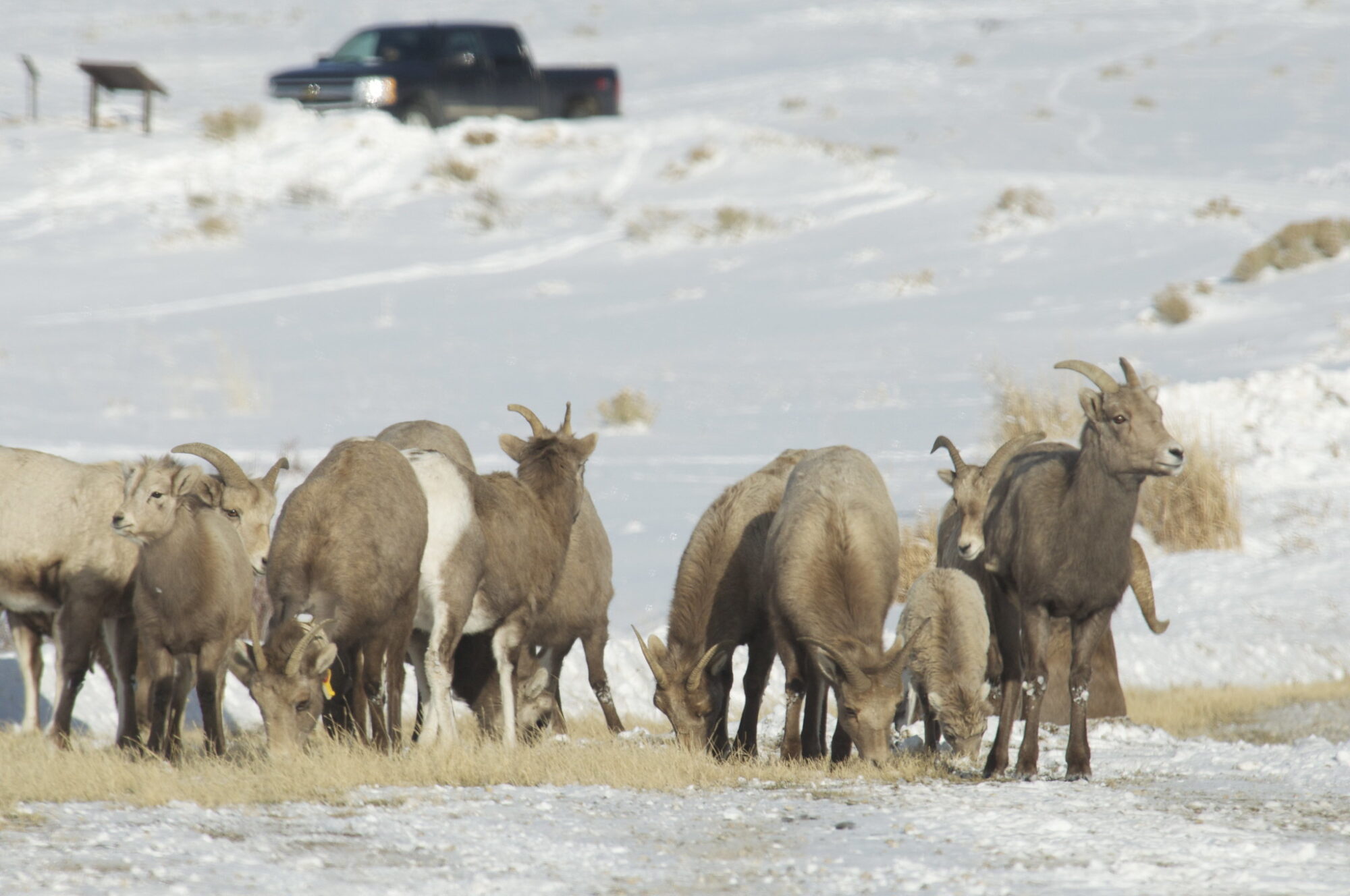As March unfolds, much of North America is still blanketed in snow. Late-season storms churn over mountains and prairies, temperatures take sudden dives, and it feels like winter will never end. But while we humans get sick of the inconveniences that come with cold weather, wild game (mostly) avoids falling victim to winterkill by drawing on waning fat reserves and munching on last-resort food sources that are better suited for kindling fires than filling stomachs. (Unpleasant though that sounds, at least they don’t stiffen and fall from trees like cold-blooded reptiles.)
In some parts of the country, recent winter conditions have triggered emergency feeding programs for deer that struggle to paw through record snowfall and ice to access forage. Heavy snowfall out West has also triggered a shed-hunting ban in Utah to avoid pressuring wintering deer and elk. But for the most part, wild animals are left to their own devices, and according to biologists, that’s how it should be. Yes, some individual animals will die of winterkill this year and in other years with brutal winter weather. But the populations themselves will remain relatively stable. Deer, elk, turkeys, and other wild game have been surviving winterkill conditions for millennia without human intervention. While harsher winters do tend to take out the weaker individuals quicker, they also make for rich spring green-ups that help wildlife recuperate after their months-long struggle.
From ruminant stomachs to feet that don’t get cold, these adaptations have allowed some of North America’s most iconic game species to survive the winter.
How Do Whitetail Deer Survive Winter?
Whitetail range varies dramatically in terms of climate and winter precipitation, since it spans everywhere from Mexico to the southern half of Canada. When winter comes knocking in the more northern reaches, life slows to a near-standstill for these deer, National Deer Association chief conservation officer Kip Adams tells Outdoor Life.

“Deer are very well-built to survive winter. They do that by sort of pretending to be a bear, except they don’t hibernate,” Adams explains. “They are built to get as heavy as they can over the summer and fall, and then live off that fat during the winter. When I was in grad school, some of the research we did showed that does entered winter with about a 90-day fat supply. Adult deer get about half of their daily energy and nutrition from tissue fat. They change their behavior in the winter so they can slow the use of that fat.”
Whitetail Deer Move Less in Winter
Whitetails in the chillier regions have evolved with different body types than those in warmer areas. According to Adams, cold-adapted whitetails have larger bodies with shorter legs, which helps them conserve heat. They also minimize their daily energy output.
“Behaviorally, these deer reduce their activity so that they’re only active during the warmer periods of the day.”
What Do Deer Eat in the Winter?
A whitetail’s winter diet depends on its region. If a deer herd lives near big timber stands where they can bed under thick canopies and shelter from the wind (a tactic Adams calls “yarding up”), those deer are more likely to have access to browse and leftover mast. This is especially true if deciduous trees have produced acorns and can keep the thick snow at bay so deer can access them on the ground.
“They want to eat because it at least gives them some calories and it also helps them maintain body temperature, since one of the byproducts of digestion is heat,” says Adams. “So even though they’re eating low-quality food, their stomachs are full. It’s churning and digesting, and heat is given off, so that helps the deer maintain body temperature without having to use as much of its fat reserves.”
Things turn south when people try to feed deer throughout the winter, especially if they put out corn in an area where deer aren’t otherwise eating any. Feeding deer corn can actually lead to winterkill in certain circumstances.
“Deer in poor shape that eat poor-quality forage are not used to eating corn. That high-energy food can shock their system and even kill the deer. It’s called acidosis,” Adams explains. “They need the right microflora in their stomach to digest the food they eat. It’s not like how we can eat a cheeseburger today and pizza tomorrow and salad the next day and we’re good. When deer start eating a new food, they have to eat that new food for one to two weeks before all that bacteria in their stomach gets converted to use the nutrition from that new food. Winter feeding is one of the single worst things you can do for whitetail deer.”
How Do Elk and Mule Deer Survive Winterkill?
Winters in the higher altitudes of the Rocky Mountain Front can be long and brutal. Much like whitetail deer, mule deer and elk can only build up so many days of fat reserves before winter conditions arrive. The risk of winterkill for deer and elk increases when cold weather stretches on for ages and spring green-up gets delayed.
“In 2020 and 2021 in Montana, our first snowfall occurred around Oct. 17 and our last one occurred around May 17,” Montana Fish, Wildlife, and Parks game management bureau chief Brian Wakeling tells Outdoor Life. “Despite the fact that we didn’t have an awful lot of snowpack that year, that’s still a long winter.”

While adult elk and mule deer can be at risk of succumbing to such conditions, the younger populations are usually the most vulnerable to death during tough winter months. But both species have evolved to survive on woody, shrubby growth full of cellulose and very little nutritional content when they have little else to eat. Mule deer seek out more browse species from high-growing shrubs and trees, while elk remain more reliant on grass and other forage species. But neither are really feasting like royalty.
“Here’s an analogy: If you were to consider mule deer and elk foraging as them eating cereal out of a box, they spend most of the year eating cereal. During the winter, they eat the box,” Wakeling says. “They’re designed to put on weight during the spring, summer, and even into the fall, and then lose weight throughout the winter.”
Elk and mule deer are also just as susceptible to acidosis as whitetails are, although in the West the culprit tends to be alfalfa rather than corn.

“Historically, a lot of well-intentioned people would take alfalfa and drop it out there where animals could eat it during a hard winter,” Wakeling says. “But there’s a lot of stories from back in the day of deer and elk dying with full bellies, because you’re changing [them] from such a low-protein diet. Alfalfa is around 18 percent protein, and that benefits an animal if it’s able to digest it. But most of the forage deer and elk consume out on the landscape is more like 2 to 4 percent protein, and the microflora in the rumen is not capable of making that change rapidly. So they starve to death with full stomachs.”
How Do Mule Deer and Elk Stay Warm?
When it comes to keeping warm in brutal temperatures, elk have a slight advantage over mule deer at avoiding winterkill. Elk are bigger, which means they have more “thermal inertia.” In other words, their body temperature stays more consistent than a smaller animal’s would. But most of a mule deer or elk’s ability to stay warm comes down to how much food it eats on a given day.
“A lot of the time, it boils down to what kind of forage is available, and what kind of intake they can pair with that [thermal inertia],” Wakeling says. “If they are forced into a situation where they’re competing with other grazing ungulates—horses, bison, or cattle—sometimes the grass is what’s the least available and most challenging to get. Deer tend to [birth twins] more frequently and their ability to rebound can be more rapid. But elk tend to live longer, so you’ve got both of those variables to look at.”
How Do Turkeys Survive Winterkill Conditions?
It’s hard to not shiver while watching a turkey meandering across snow and ice with its scaly feet, the wind whipping past their bald, featherless heads. In short, these birds don’t exactly look cold-weather-optimized. But according to Wisconsin Department of Natural Resources biologist Alaina Gerrits, turkeys do better at avoiding winterkill than you might expect.
Vilas County, where Gerrits studies turkeys and other game birds, is one of Wisconsin’s northernmost counties and regularly sees pretty treacherous winters. But Gerrits loves reminding people that robust wild turkey flocks live in every one of Wisconsin’s counties, and most of them make it through the winters just fine.
“Overwinter survival is pretty high. The hardest thing for turkeys to deal with is really deep, really powdery snow,” Gerrits tells Outdoor Life. “But even with a lot of snow, on the southern-facing slopes there’s usually lots of bare ground that gets sunlight most of the day. So there are places for them to scratch for acorns. They will switch their feeding habits, they’ll move to eating buds, dead fernheads, any kind of exposed seed pods, [and] they might eat aspen catkins or birch catkins. So their diet will change drastically in the winter to accommodate not being able to scratch through the snow.”
Turkeys Stay Together, and Out of Reach
As for keeping warm and avoiding predators, turkeys spend a lot of time in their roosts where they can ride out single-digit to negative temperatures, raptors, and small carnivores.

“Those days that are below zero all day are the hardest for turkeys to cope with. They will have to use the most energy and resources during those days,” Grits explains. “But we calculate an index called the Winter Severity Index, which we use mostly for deer management. The score looks at days that we have below-zero temperatures and days with above 18 inches of snow cover. We add those up and that creates a Winter Severity Index. Even with the snow we’ve had, our WSI has been fairly low this year, just about creeping into the moderate range. Turkeys are probably still doing fairly well.”
Wild turkeys have several layers of down and feathers that cover most of their bodies. Like other birds, they can puff up their plumage to trap warm air close to their bodies. On really cold days, turkeys stick tight to their roosts and keep their feet tucked under their bodies and feathers. These birds rely on what’s called a countercurrent exchange to keep their feet from freezing.
“When they’re taking warm blood from their body and cycling it through their feet, the warmth from the blood goes back up into the [turkey’s] body before it goes down into the feet,” Gerrits says. “Their circulation systems are so quick that the blood never freezes in their feet. So they have some physiological adaptations as well. Turkey feet are almost all tendon and bone, with very little nerve endings or tissue. So when it gets cold, they don’t really sense it like we do when we have cold feet.”
How Do Pheasants Survive Winter?
Game birds tend to look small and fragile when contrasted against vast expanses of snow. It’s impressive that pheasants avoid winterkill as well as they do, especially since they’re native to China and their range covers some of the snowiest parts of North America.
Rachel Bush is the private lands conservation program manager with Pheasants Forever and a trained wildlife biologist. As a longtime resident of Bismarck, North Dakota, she knows a thing or two about pheasants surviving tough winters.
Winter Habitat is Critical for Pheasant Survival
“Pheasants are an introduced species to the United States. They’ve adapted to winter conditions and they’ve thrived in areas that meet their life history needs, throughout the nesting season, throughout the summer brooding period, and throughout the winter,” Bush explains. “The species has experienced these harsh winters in the past, and we still have pheasants on the landscape. Yes the winter is severe, but we’re not going to wipe out our population. They’ve survived in the northern Great Plains and the Midwest for a long time.”

In order for pheasants to ride out the frozen hellscape that North Dakota turns into every year, they rely on high-quality winter cover, Bush says. Shelter—a cozy spot to avoid drifting snow and swirling winds—might be the most important factor for surviving winterkill conditions.
“Habitat is key, and it needs to be there before severe weather strikes. There’s not much at this point [in the season] that we can provide for pheasants that would help them survive,” Bush says. “Primary high-quality winter habitat is mostly cattail sloughs, thick cattail wetlands. Those cattails provide a lot of thermal cover in most winters. They won’t get completely filled in with snow, so birds will be able to roost and get protection from the elements.”
What Do Pheasants Eat in the Winter?
Food, on the other hand, is less of a concern—unless it requires a long trip from the cattails. Wind-exposed waste grain and sturdy berries that cling to branches throughout the winter comprise much of their diet. They also scratch under the snow for food, but of course this gets harder to do when inch after inch stacks up.
“Pheasants rarely starve to death,” Bush says. “Lack of food is typically not the reason we see winter mortality. It’s more likely exposure to elements. If pheasants are being pulled away from high quality winter cover for food, and are being exposed to the elements that way, that’s more likely the reason for mortality than starvation.”
For this reason, Bush and Pheasants Forever ask the public not to feed pheasants, no matter how bad the weather gets. It’s an attractive nuisance. If you put out food that draws pheasants from their winter cover, they could die trying to return. Think of it like driving three hours in the worst weather imaginable to hit the Chick-Fil-A drive-thru: you’re risking your life for a sandwich you probably don’t need.
“People are concerned,” Bush says of winterkill. “They see a lot of snow, they see pheasants, they want to help them today. But our organization and state agencies really try to discourage people from doing any supplemental feeding. It draws birds away from cover and then they do have increased exposure. It also congregates them, bringing in unnatural numbers to that food source which makes them more susceptible to predation, and there’s always the risk of disease transmission if you’re congregating animals unnaturally. And if wildlife becomes dependent on that food source during a harsh winter and then it stops—you’ve drawn them away from good thermal cover, natural food sources, and then you cut off that food supply—you’re exposing them to more risk.”
How Do Sheep Survive Winterkill?
High alpine regions are some of the most predisposed to brutal winter conditions—and winterkill. How many times have we humans sat comfortably in a valley or basin and looked up to see thick clouds of snow frothing over the surrounding mountains? It’s a good thing wild sheep are some of the most adaptable critters in the backcountry, according to Wild Sheep Foundation vice president of conservation and longtime wildlife biologist Kevin Hurley.
“Wild sheep obviously run the spectrum from high alpine far north in Alaska and the Northwest Territories all the way down to six states in Mexico, so they’re built to handle a variety of weather conditions and environmental challenges,” Hurley tells Outdoor Life. “Rocky Mountain sheep occur in 16 different states. If you think about the classic Northern Rockies, where it’s windy, sheep can do alright because the snow is light enough that the wind will scour certain hillsides and south-facing slopes that might melt off or blow off. So it’s pretty critical that you have wind scour patterns that the animals have adapted to.”
What Do Wild Sheep Eat in the Winter?
Wild sheep welcome these aggressive winds and can stand up to the frigid temperatures that come with them. Trouble sets in when freeze-thaw cycles create what Hurley describes as a “layer cake” of snow and ice that hides their forage. When sheep can’t paw through the ground cover, they must resort to other shrubby, woody food sources and rely on fat stores from the warmer months.

“Their metabolism doesn’t necessarily slow down like a bear, so they have to eat all day, every day,” Hurley explains. “Fortunately they’re a ruminant, so they can process some rougher forage that’s not super high-quality just to get by. In summer, those animals are putting on fat deposits that will carry them through the winter and it’s always a race against time to get them to spring green-up.”
So why don’t wild sheep follow other grazing animals and come down to lower elevations for the winter months to avoid conditions that contribute to winterkill? Well, according to Hurley, some do. But other herds have adapted to staying high and taking a gamble to avoid human and predator interactions.
“You really need to minimize disturbance to these animals, because energetically, if you cost them a whole bunch of whatever energy they’ve built up, they can’t restore that,” Hurley says. “There are some sheep that stay high and never come down. Predation is probably somewhat reduced. Instead of a mountain lion living up at 11,000 feet in the wintertime, that mountain lion is probably down lower, chasing deer or some alternate prey. So when sheep choose to winter up high, it’s worked for their predecessors, so somehow they know it’s okay to stay up there, even post-rut when they’ve depleted so much of their energy reserves.”
Helping Wildlife Avoid Winterkill
Wildlife species of all kinds have been evolving since their inception to survive winter weather and dodge winterkill. So if you see a worn-down critter in the woods, don’t assume that it’s actually struggling more than it normally would. In fact, it’s probably just slowing down its lifestyle to spend less energy and hang onto fat for as long as possible. But with that said, yes—more wildlife will die during harsh winters than mild ones. This is especially true for sick, injured, or older animals.
Across the board, the worst thing we can do during a harsh winter is to try feeding wildlife and negatively impacting their habitat, especially when they should be relying on their instincts and learned knowledge to find both themselves. And in truly dire straits, leave the feeding and management to the state agency and leave the animals alone. The last thing you want to do is force them to use up more energy getting away from you.
Read Next: The 10 Best Winter Survival Tips
“We appreciate people wanting to help the deer, but we strongly discourage people from feeding hay or other things to deer,” Utah DNR Northern Region Wildlife Manager Jim Christensen said in a press release. “These are special circumstances that follow Division policies, involve trained professionals and utilize specialized feed. We still recommend that the public doesn’t feed wildlife, due to safety concerns, among other things.”
